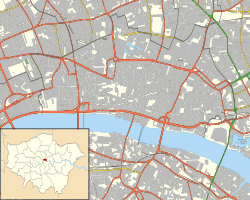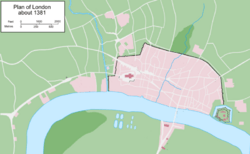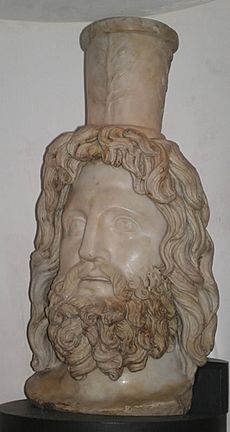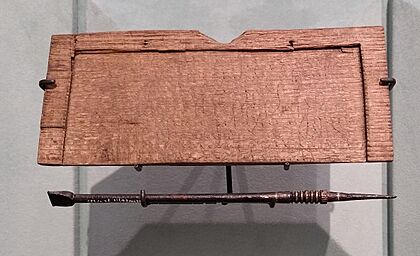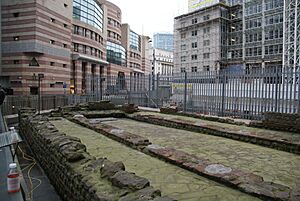London Mithraeum facts for kids
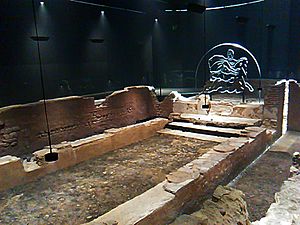
The Mithraeum in 2017, in the Bloomberg Space
|
|
| Location | 12 Walbrook, London, EC4 |
|---|---|
| Coordinates | 51°30′45″N 00°05′26.16″W / 51.51250°N 0.0906000°W |
| Type | Sanctuary |
| History | |
| Periods | Roman Imperial |
The London Mithraeum, also called the Temple of Mithras, Walbrook, is a Roman temple. It was found in 1954 in Walbrook, a street in the City of London. Workers discovered it while building a new office block.
The whole site was moved so construction could continue. This temple, dedicated to the mysterious Roman god Mithras, became one of the most famous Roman discoveries in London during the 1900s.
Contents
Discovering the Temple
Archaeologists W. F. Grimes and Audrey Williams led the dig in 1954. They were from the Museum of London. At first, people thought the building might be an early Christian church.
The temple was built around 250 AD. It was dedicated to Mithras, or perhaps to several gods popular with Roman soldiers. Later, in the early 300s AD, it was rededicated to Bacchus.
Amazing Artefacts
Inside the temple, archaeologists found beautiful white marble statues. These statues were carefully buried when the temple was rededicated. They included figures of Minerva, Mercury, Mithras, and Serapis. These statues were brought all the way from Italy.
They also found some rougher clay figures of Venus. These were made locally and showed Venus combing her hair. All these amazing items were put on display at the Museum of London.
One special find was a head of Mithras himself. You can tell it's him by his Phrygian cap. The bottom of the head was shaped to fit onto a body, but the body was not found.
Archaeologist Ralph Merrifield believed that other items found in Walbrook in 1889 also came from this temple. One was a marble carving, about half a metre tall. It showed Mithras killing a bull. This act, called the Tauroctony, was very important to followers of Mithras. It was as central to their religion as the Crucifixion is to Christianity.
The carving also shows two small figures holding torches. These are Cautes and Cautopates, who represent light and darkness. Around them is a circle showing the zodiac signs. At the top left, the sun god Sol–Helios rides his chariot into the sky. At the top right, the moon goddess Luna rides her chariot down. Heads of two wind gods, Boreas and Zephyros, are in the bottom corners.
The carving has an inscription that says:
ULPIUS SILVANUS EMERITUS LEG II AUG VOTUM SOLVIT FACTUS ARAUSIONE
This can be translated as: "Ulpius Silvanus, a retired soldier from the Second Augustan Legion, fulfilled his promise after becoming a Mithraist at Orange."
Other buried heads found nearby included the Roman goddess Minerva and a detailed bearded head of Serapis. Serapis looks like Jupiter but can be recognized by the grain-basket, called a modius, on his head. This basket was a symbol of new life.
Another inscription from around 307–310 AD was found. It reads:
PRO SALVTE D N CCCC ET NOB CAES DEO MITHRAE ET SOLI INVICTO AB ORIENTE AD OCCIDENTEM
This means: "For the safety of our four emperors and the noble Caesar, and to the god Mithras, the Invincible Sun from east to west."
More Recent Discoveries
Between 2010 and 2014, the Museum of London Archaeology team dug up more of the site. They found over 14,000 items, including many tools. These objects were likely brought to the site in soil and landfill from other places. This was done to improve the marshy banks of the River Walbrook after the Boudican revolt in 60 or 61 AD.
The wet soil conditions helped preserve things that usually rot away. This included leather shoes and over 400 wooden writing tablets. These tablets originally had a layer of dark wax. Messages were scratched into the wax with a stylus, showing the lighter wood underneath. The wax is gone now, but the words were recreated from the scratch marks in the wood.
Among these messages is the oldest financial document from London, dated 57 AD. There are also two addresses from 62 AD and 70 AD. These are the earliest mentions of London ever found.
Moving the Temple
When the Roman temple was first built, it stood on the east bank of the River Walbrook. This river, now covered over, was an important source of fresh water in Roman Londinium.
Nearby, in the old riverbed, a small hammered lead sheet was found. Someone named Martia Martina had her name written backwards on it by an enemy. This sheet was thrown into the stream. This was a traditional Celtic way to reach the gods. Similar metal tokens have been found in rivers across Celtic Europe, from ancient times to Roman times.
The temple's foundations are very close to other important places in the City of London. These include the historic London Stone, the Bank of England, and the London Wall. The original Mithraeum was built partly underground. This was to remind people of the cave of Mithras, where important religious events happened.
The temple site was found in September 1954. This was during digging for a new office building called Bucklersbury House. To allow the building work to continue, the temple ruins were carefully taken apart. They were then moved 100 metres away to Temple Court, Queen Victoria Street. In 1962, the foundations were put back together at street level for people to see outdoors. However, this reconstruction was not completely accurate and received some criticism.
In 2007, there were plans to move the Mithraeum back to its original spot. This was because Bucklersbury House was going to be torn down. However, these plans were put on hold in 2008 due to disagreements.
The Temple's New Home
The Bloomberg company bought the Walbrook Square project in 2010. They decided to restore the Mithraeum to its original location. It is now part of their new European headquarters. The temple is displayed about 7 metres below the modern street level. It is part of an exhibition space under the Bloomberg building.
The temple was moved a little west of its exact original spot. This was done to protect parts of the walls that were not found in the 1950s. These parts are too fragile to display today.
The ruins are rebuilt to look like they did when they were first found in 1954. This shows the temple's first building phase from around 240 AD. Most of the stones and bricks are original. The wood, plaster, and mortar are new. However, they are based on samples from other Roman buildings in London from that time. The temple is displayed with some of the artefacts found at the site.
Images for kids
-
White marble relief depicting Mithras slaying the bull, found at the Walbrook site and put on display at the Museum of London (as of 2024 closed for redevelopment)
See also
 In Spanish: Mitreo de Londres para niños
In Spanish: Mitreo de Londres para niños


